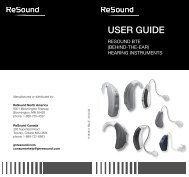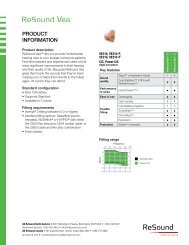ReSound Vea Behind-the-Ear (BTE) User Guide
ReSound Vea Behind-the-Ear (BTE) User Guide
ReSound Vea Behind-the-Ear (BTE) User Guide
You also want an ePaper? Increase the reach of your titles
YUMPU automatically turns print PDFs into web optimized ePapers that Google loves.
General warnings<br />
1. Consult a hearing care professional if you discover a foreign<br />
object in your ear canal, if you experience skin irritation,<br />
or if excessive ear wax accumulates with <strong>the</strong> use of<br />
<strong>the</strong> hearing instrument.<br />
2. Different types of radiation, from e.g. NMR, MRI, or CT<br />
scanners, may damage hearing instruments. It is recommended<br />
not to wear hearing instruments during <strong>the</strong>se or<br />
o<strong>the</strong>r similar procedures. O<strong>the</strong>r types of radiation, such as<br />
burglar alarms, room surveillance systems, radio equipment,<br />
mobile telephones, contain less energy and will not<br />
damage hearing instruments. However, <strong>the</strong>y have <strong>the</strong> potential<br />
to momentarily affect <strong>the</strong> sound quality or temporarily<br />
create strange sounds from hearing instruments.<br />
3. Do not wear hearing instruments in mines, oil fields, or<br />
o<strong>the</strong>r explosive areas unless those areas are certified for<br />
hearing instrument use.<br />
4. Do not allow o<strong>the</strong>rs to use your hearing instruments. This<br />
may cause damage to <strong>the</strong> hearing instruments or to <strong>the</strong><br />
hearing of <strong>the</strong> o<strong>the</strong>r individual.<br />
5. Instrument usage by children or mentally challenged persons<br />
should be supervised at all times to ensure <strong>the</strong>ir safety.<br />
The hearing instrument contains small parts that could<br />
be swallowed by children. Please be mindful not to leave<br />
children unsupervised with this hearing instrument.<br />
6. Hearing instruments should be used only as prescribed by<br />
your hearing care professional. Incorrect use may result in<br />
hearing loss.<br />
7. Warning to hearing care professionals: Special care should<br />
be exercised in selecting and fitting hearing instruments<br />
with maximum sound pressure level that exceeds 132dB<br />
SPL with an IEC 60711:1981 occluded ear simulator. There<br />
may be a risk of impairment of <strong>the</strong> remaining hearing.<br />
8. External devices connected to <strong>the</strong> electrical input must be<br />
safe according to <strong>the</strong> requirements of IEC 60601-1-1, IEC<br />
60065, or IEC 60950-1, as appropriate.<br />
Battery warning information<br />
1. Do not put batteries in your mouth, as <strong>the</strong>y can be harmful<br />
if swallowed. If swallowed, seek medical help immediately.<br />
2. Keep batteries away from children and mentally challenged<br />
persons.<br />
3. Remove <strong>the</strong> batteries to prevent leakage when <strong>the</strong> hearing<br />
instruments are not in use for an extended period of time.<br />
4. Do not attempt to recharge batteries (Zinc Air) which are<br />
not specifically designated as rechargeable because <strong>the</strong>y<br />
may leak or explode.<br />
5. Do not attempt to dispose of batteries by burning <strong>the</strong>m.<br />
6. Used batteries are harmful to <strong>the</strong> environment. Please dispose<br />
of <strong>the</strong>m according to local regulations or return <strong>the</strong>m<br />
to your hearing care practitioner.<br />
Warning to hearing aid dispensers:<br />
A hearing aid dispenser should advise a prospective hearing<br />
aid user to consult promptly with a licensed physician (preferably<br />
an ear specialist) before dispensing a hearing aid, if<br />
<strong>the</strong> hearing aid dispenser determines through inquiry, actual<br />
observation, or review of any o<strong>the</strong>r available information concerning<br />
<strong>the</strong> prospective user, that <strong>the</strong> prospective user has<br />
any of <strong>the</strong> following conditions:<br />
(i) Visible congenital or traumatic deformity of <strong>the</strong> ear.(ii) History<br />
of active drainage from <strong>the</strong> ear within <strong>the</strong> previous 90 days.<br />
(iii) History of sudden or rapidly progressive hearing loss<br />
within <strong>the</strong> previous 90 days.(iv) Acute or chronic dizziness.<br />
(v) Unilateral hearing loss of sudden or recent onset within<br />
<strong>the</strong> previous 90 days.(vi) Audiometric air-bone gap equal to<br />
or greater than 15 decibels at 500 hertz (Hz), 1,000 Hz, and<br />
2,000 Hz.(vii) Visible evidence of significant cerumen accumulation<br />
or a foreign body in <strong>the</strong> ear canal.(viii) Pain or discomfort<br />
in <strong>the</strong> ear.<br />
22 23





